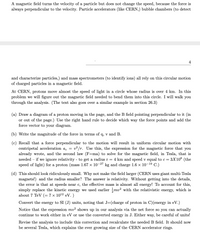
College Physics
11th Edition
ISBN: 9781305952300
Author: Raymond A. Serway, Chris Vuille
Publisher: Cengage Learning
expand_more
expand_more
format_list_bulleted
Concept explainers
Question
Answer all parts of the PHY problem please

Transcribed Image Text:A magnetic field turns the velocity of a particle but does not change the speed, because the force is
always perpendicular to the velocity. Particle accelerators (like CERN,) bubble chambers (to detect
4
and characterize particles,) and mass spectrometers (to identify ions) all rely on this circular motion
of charged particles in a magnetic field.
At CERN, protons move almost the speed of light in a circle whose radius is over 4 km. In this
problem we will figure out the magnetic field needed to bend them into this circle. I will walk you
through the analysis. (The text also goes over a similar example in section 26.3)
(a) Draw a diagram of a proton moving in the page, and the B field pointing perpendicular to it (in
or out of the page.) Use the right hand rule to decide which way the force points and add the
force vector to your diagram.
(b) Write the magnitude of the force in terms of q, v and B.
(c) Recall that a force perpendicular to the motion will result in uniform circular motion with
v2 /r. Use this, the expression for the magnetic force that you
centripetal acceleration a. =
already wrote, and the second law (F=ma) to solve for the magnetic field, in Tesla, that is
needed – if we ignore relativity - to get a radius r = 4 km and speed v equal to c = 3X10$ (the
speed of light) for a proton (mass 1.67 x 10-27 kg and charge 1.6 × 10-19 C.)
(d) This should look ridiculously small. Why not make the field larger (CERN uses giant multi-Tesla
magnets!) and the radius smaller? The answer is relativity. Without getting into the details,
the error is that at speeds near c, the effective mass is almost all energy! To account for this,
simply replace the kinetic energy we used earlier mv? with the relativistic energy, which is
about 7 TeV (= 7 × 1012 eV. )
Convert the energy to SI (J) units, noting that J=(charge of proton in C)(energy in eV.)
Notice that the expression mv² shows up in our analysis via the net force so you can actually
continue to work either in eV or use the converted energy in J. Either way, be careful of units!
Revise the analysis to include this correction and recalculate the needed B field. It should now
be several Tesla, which explains the ever growing size of the CERN accelerator rings.
Expert Solution
This question has been solved!
Explore an expertly crafted, step-by-step solution for a thorough understanding of key concepts.
Step by stepSolved in 5 steps with 1 images

Knowledge Booster
Learn more about
Need a deep-dive on the concept behind this application? Look no further. Learn more about this topic, physics and related others by exploring similar questions and additional content below.Similar questions
arrow_back_ios
arrow_forward_ios
Recommended textbooks for you
 College PhysicsPhysicsISBN:9781305952300Author:Raymond A. Serway, Chris VuillePublisher:Cengage Learning
College PhysicsPhysicsISBN:9781305952300Author:Raymond A. Serway, Chris VuillePublisher:Cengage Learning University Physics (14th Edition)PhysicsISBN:9780133969290Author:Hugh D. Young, Roger A. FreedmanPublisher:PEARSON
University Physics (14th Edition)PhysicsISBN:9780133969290Author:Hugh D. Young, Roger A. FreedmanPublisher:PEARSON Introduction To Quantum MechanicsPhysicsISBN:9781107189638Author:Griffiths, David J., Schroeter, Darrell F.Publisher:Cambridge University Press
Introduction To Quantum MechanicsPhysicsISBN:9781107189638Author:Griffiths, David J., Schroeter, Darrell F.Publisher:Cambridge University Press Physics for Scientists and EngineersPhysicsISBN:9781337553278Author:Raymond A. Serway, John W. JewettPublisher:Cengage Learning
Physics for Scientists and EngineersPhysicsISBN:9781337553278Author:Raymond A. Serway, John W. JewettPublisher:Cengage Learning Lecture- Tutorials for Introductory AstronomyPhysicsISBN:9780321820464Author:Edward E. Prather, Tim P. Slater, Jeff P. Adams, Gina BrissendenPublisher:Addison-Wesley
Lecture- Tutorials for Introductory AstronomyPhysicsISBN:9780321820464Author:Edward E. Prather, Tim P. Slater, Jeff P. Adams, Gina BrissendenPublisher:Addison-Wesley College Physics: A Strategic Approach (4th Editio...PhysicsISBN:9780134609034Author:Randall D. Knight (Professor Emeritus), Brian Jones, Stuart FieldPublisher:PEARSON
College Physics: A Strategic Approach (4th Editio...PhysicsISBN:9780134609034Author:Randall D. Knight (Professor Emeritus), Brian Jones, Stuart FieldPublisher:PEARSON

College Physics
Physics
ISBN:9781305952300
Author:Raymond A. Serway, Chris Vuille
Publisher:Cengage Learning

University Physics (14th Edition)
Physics
ISBN:9780133969290
Author:Hugh D. Young, Roger A. Freedman
Publisher:PEARSON

Introduction To Quantum Mechanics
Physics
ISBN:9781107189638
Author:Griffiths, David J., Schroeter, Darrell F.
Publisher:Cambridge University Press

Physics for Scientists and Engineers
Physics
ISBN:9781337553278
Author:Raymond A. Serway, John W. Jewett
Publisher:Cengage Learning

Lecture- Tutorials for Introductory Astronomy
Physics
ISBN:9780321820464
Author:Edward E. Prather, Tim P. Slater, Jeff P. Adams, Gina Brissenden
Publisher:Addison-Wesley

College Physics: A Strategic Approach (4th Editio...
Physics
ISBN:9780134609034
Author:Randall D. Knight (Professor Emeritus), Brian Jones, Stuart Field
Publisher:PEARSON